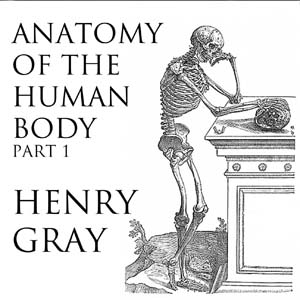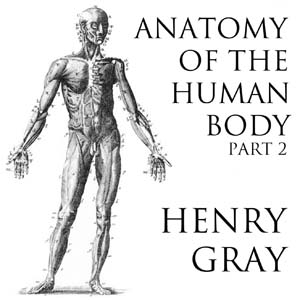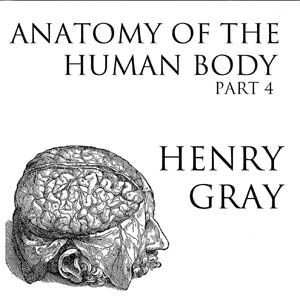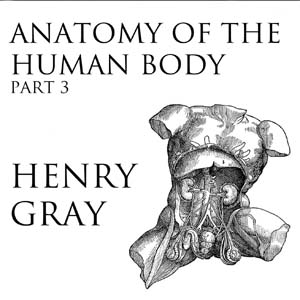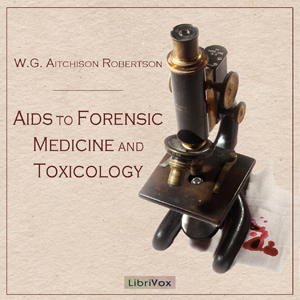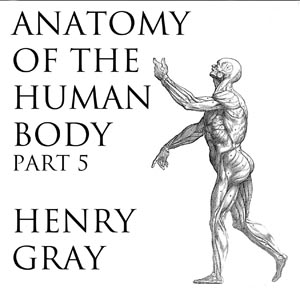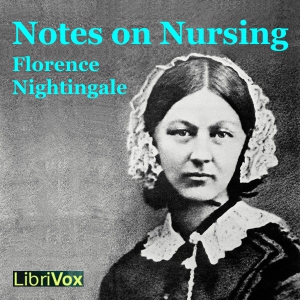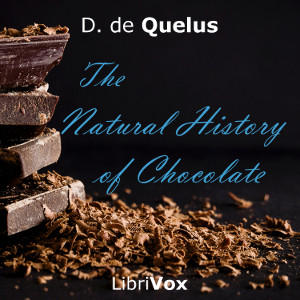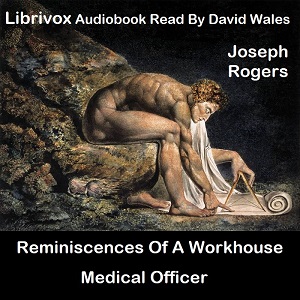Henry Gray's classic anatomy textbook was first published in 1858 and has been in continuous publication ever since, revised and expanded through many successive editions. This recording is of the public-domain 1918 US edition (some information may be outdated). The illustrations can be found in the online text at bartleby.com. For the Librivox recording, we have divided the book into five parts. Part 1 includes the Embryology and Osteology sections. (summary by Laurie Anne Walden)
52 episodes
Henry Gray's classic anatomy textbook was first published in 1858 and has been in continuous publication ever since, revised and expanded through many successive editions. This recording is of the public-domain 1918 US edition (some information may be outdated). For the Librivox recording, we have divided the book into five parts. Part 2 includes Syndesmology and Myology. The mathematical formulas (section 25) and the illustrations can be found in the online text at bartleby.com. (Summary by Laurie Anne Walden)
55 episodes
Henry Gray's classic anatomy textbook was first published in 1858 and has been in continuous publication ever since, revised and expanded through many successive editions. This recording is of the public-domain 1918 US edition (some information may be outdated). The illustrations can be found in the online text at bartleby.com. For the Librivox recording, we have divided the book into five parts. Part 4 includes Neurology, the Organs of the Senses, and the Common Integument. (summary by Laurie Anne Walden)
63 episodes
Henry Gray's classic anatomy textbook was first published in 1858 and has been in continuous publication ever since, revised and expanded through many successive editions. This recording is of the public-domain 1918 US edition (some information may be outdated). The illustrations can be found in the online text at bartleby.com. For the Librivox recording, we have divided the book into five parts. Part 3 includes Angiology, Arteries, Veins, and the Lymphatic System. (Summary by Laurie Anne Walden)
50 episodes
Ward Muir brings us into the heart of an English war hospital, describing scenes of cleanliness, triumph, order and sadness. Through the eyes of the orderly we get to see the processes that kept the wards running, and relive some tales from within the hospital walls. (Summary by Christine Blachford)
15 episodes

Dr. Walsh's Old-Time Makers of Medicine chronicles the history and development of modern medicine from ancient times up to the discovery of America. Throughout this historical guide, Dr. Walsh shows numerous examples of practices thought to be entirely modern that were clearly anticipated hundreds or thousands of years ago. Ancient healers sought to use the body's natural healing ability, rather than rely exclusively on external cures. Physicians even in ancient times relied on what is now recognized as the placebo effect.Dr. Walsh also addresses training and certification in medicine. Medieval universities anticipate our modern medical textbooks with consolidated records of all research and independent investigations, to provide uniform training for students. Likewise, the reader will find that the ancients reacted to unsuccessful treatment in similar degrees to what might now be called medical malpractice suits.The book is organized chronologically, beginning with the fall of the Roman Empire and growth of the early Christian Church. From there, Dr. Walsh details the development of medical knowledge and practice in Arabia, to Medieval and Renaissance Europe. The reader will also discover how modern cultures based much of their medical knowledge on ancient Greek teachings. The chapters on Arabian Physicians and Medieval Universities also discuss knowledge exchanged between Arabic and European cultures. Dr. Walsh exposes several misconceptions and misinterpretations of history, especially restrictions of medical research stemming from religious prohibitions. (Summary by LivelyHive)
29 episodes
A 1922 source-book for British criminal pathologists, this will be of particular interest to fans of popular police forensics television shows, films, and murder mysteries.(Summary by BellonaTimes)
19 episodes
Henry Gray's classic anatomy textbook was first published in 1858 and has been in continuous publication ever since, revised and expanded through many successive editions. This recording is of the public-domain 1918 US edition (some information may be outdated). The illustrations can be found in the online text at bartleby.com. For the Librivox recording, we have divided the book into five parts. Part 5 includes Splanchnology and Surface Anatomy and Markings. (Summary by Laurie Anne Walden)
59 episodes
Notes on Nursing was published in 1859 and is a fascinating view into the theories underpinning the early development of modern nursing and public health reform by "the Lady with the Lamp", Florence Nightingale. Emphasising common sense and thought for the patient's care in many more ways than just administering physician-prescribed medicines, this is still a very relevant book for those interested in health or caring for the sick and infirm today.Summary by Cori Samuel.
15 episodes
One of the first volumes dedicated to systematized medical treatment of soldiers in modern warfare, including a chapter on specific care for airmen, by British doctors who served on the front lines of WWI. Graphic descriptions (and images in the source book) of war wounds are not for the weak of heart. - Summary by BellonaTimes
40 episodes

Mahatma Gandhi, known today as a fascinating political leader and pacifist, also considered himself "something of an authority on matters of Health and Disease as well. Very few of us perhaps are aware that he is the author of quite an original little Health-book in Gujarati. [...] His views are of course radically different from the ordinary views that find expression in the pages of such books; in many cases, indeed, his doctrines must be pronounced revolutionary, and will doubtless be regarded by a certain class of readers as wholly impracticable. Even the most revolutionary of his doctrines, however, are based, not on the shifting quicksands of mere theory, but on the solid foundation of deep study, backed up by personal experience of nearly thirty years. He himself recognizes that many of his views will hardly be accepted by the ordinary reader, but he has felt himself impelled by a stern sense of duty to give publicity to his convictions formed after so much of study and experience" (Preface).
Though his advice may appear socially outdated or medically obvious/dubious to his modern day audience based on what we know now, Gandhi's treatise still provides a fascinating look on maintaining good health as it was understood in the early twentieth century. - Summary by Mary Kay and A. Rama Iyer
24 episodes
Here are thirteen biographical sketches of physicians penned by one of the founders of modern medicine, William Osler, published in 1908. "Sir William Osler, one of the best-loved and most influential teachers of his time, was born in Canada in 1849…. Wherever he worked his gifted and unique personality was a center of inspiration… one would like to see his honorable place as a man of letters more generally understood. His generous wisdom and infectious enthusiasm are delightfully expressed in his collected writings…. His lucid and exquisite prose, with its extraordinary wealth of quotation from the literature of all ages, and his unfailing humor and tenderness, put him in the first rank of didactic essayists…. Rich in every gentle quality that makes life endeared, his books are the most sagacious and helpful of modern writings…" - Summary by Christopher Morley, Modern Essays, 1921, and David Wales
19 episodes
Mary Edwards Walker was a physician and surgeon who served in the Civil War. An abolitionist, prohibitionist, and cross-dressing leader of the women's dress reform movement, she published this lively sex manual in 1878. It is a curious blend of useful information and Victorian sexual mythology, at once puritanical and explicit. (Summary by Pamela Nagami)
15 episodes
Louis Pasteur (1822-1895) famously said, "In the fields of observation chance favors only the prepared mind." Pasteur brought to the study of chemistry, microbiology, and applied immunology, a mind open, innovative, and insightful. Born of peasant stock in the French Jura, he worked with dogged determination all his life and often in the face of strenuous opposition. Through an unbroken succession of rigorously designed and meticulously performed experiments, Pasteur developed veterinary vaccines and halted grievous losses in the French wine, silk, and dairy industries. He provided the crucial experimental support for the germ theory of disease which enabled Joseph Lister and others to prevent infections in surgical patients and in new mothers. During the development of the vaccine against rabies, Pasteur and his colleagues often risked their own lives, but they delivered humankind from the terror of this agonizing and almost always fatal illness. (Pamela Nagami, M.D.)
15 episodes
The Natural History of Chocolate being a Distinct and Particular Account of the Cocoa-tree, its Growth and Culture, and the Preparation, Excellent Properties, and Medicinal Virtues of its Fruit. Wherein the Errors of those who have wrote upon this Subject are discovered; the Best Way of Making Chocolate is explained; and several Uncommon Medicines drawn from it, are communicated. - Summary by D. de Quelus
12 episodes
A series of lectures given in the USA by Freud in German, later translated into English - Summary by Peter Tucker
5 episodes
The Elements of Anatomy and Physiology is one in a Series of First Books of Natural History Prepared for the Use of Schools and Colleges. This succinct little textbook from 1852 presents an introduction to the workings of the human body. The information, albeit not current, is still interesting and of use as a general overview of the subject as well as interesting look into the period. Please note that some of the information may have changed considerably since this time. The author was a surgeon in the U.S. Navy and president of the Academy of Natural Sciences. - Summary by A. Gramour
14 episodes
Radioisotopes in Medicine is an educational booklet published in 1966 as part of the Understanding the Atom series by the United States Atomic Energy Commission. Written in clear language for the general public, the booklet covers the diagnostic and therapeutic uses of radioactive isotopes like technetium 99m and iodine 131. (Summary by Laurie Anne Walden)
5 episodes
Vivisection is a pejorative term used by opponents of the practice of performing operations on live animals for the purpose of physiological or pathological research. While opposition to the use of living animals for experimentation is most often associated with PETA [People for the Ethical Treatment of Animals, founded in 1980], opposition to use of live animals in physiology research dates back several centuries. Animal experimentation was particularly decried before the development of anesthesia. This book briefly describes the personal histories of twelve prominent critics of live experimentation in 19th century England. - Summary by JefferySmith
14 episodes

Naturalis Historia (Latin for "Natural History") is an encyclopedia published circa AD 77-79 by Pliny the Elder. It is one of the largest single works to have survived from the Roman empire to the modern day and purports to cover the entire field of ancient knowledge, based on the best authorities available to Pliny. The work became a model for all later encyclopedias in terms of the breadth of subject matter examined, the need to reference original authors, and a comprehensive index list of the contents. The scheme of his great work is vast and comprehensive, being nothing short of an encyclopedia of learning and of art so far as they are connected with nature or draw their materials from nature. The work divides neatly into the organic world of plants and animals, and the realm of inorganic matter, although there are frequent digressions in each section. He is especially interested in not just describing the occurrence of plants, animals and insects, but also their exploitation (or abuse) by man, especially Romans. The description of metals and minerals is particularly detailed, and valuable for the history of science as being the most extensive compilation still available from the ancient world.
This fifth volume includes books twenty one to twenty five, covering the following subjects:
Book 21 - The natural history of flowers
Book 22 - The properties of plants and fruits
Book 23 - The remedies derived from the cultivated trees
Book 24 - The remedies derived from the forest trees
Book 25 - The natural history of the wild plants - Summary by Leni
27 episodes
In 1827 Thomas Southwood-Smith published The Use of the Dead to the Living, a pamphlet which argued that the current system of burial in the United Kingdom was a wasteful use of bodies that could otherwise be used for dissection by the medical profession. "If, by any appropriation of the dead, I can promote the happiness of the living, then it is my duty to conquer the reluctance I may feel to such a disposition of the dead, however well-founded or strong that reluctance may be". Southwood-Smith's lobbying helped lead to the 1832 Anatomy Act, the legislation which allowed the state to seize unclaimed corpses from workhouses and sell them to surgical schools. While this act is credited with ending the practice of grave robbery, it has also been condemned as discriminatory against the poor. Thomas Southwood- Smith (1788 – 1861) was an English physician and sanitary reformer. - Summary by Wikipedia and David Wales
5 episodes
In 1884, Professor Treves saw Joseph Merrick (known as the "Elephant Man") in a shop across the road from the London Hospital. Being also a teacher at the University, he brought Merrick to the London Hospital as a teaching case, and Merrick lived there until his death in April 1890. This book of "reminiscences" includes the story of the "Elephant Man" as well as other interesting cases from Sir Treves' practice as a doctor. (Summary by Beth Thomas)
12 episodes
Robert James Manion (1881-1943) was a Canadian doctor who volunteered in the Canadian medical corps during World War I. This book is his memoir of the war. After the war he entered politics and served in several Canadian governments. The listener may note a lack of mention of the United States soldier; this is because the memoir was written before the entry of that country into the war. - Summary by David Wales
13 episodes
Louise Creighton (1850-1936) was a British author and women's rights activist. The wife of the Anglican bishop of London, she was the mother of seven children. In this short book, Creighton gives us chapters on such well-known women as Joan of Arc, Florence Nightingale, and Queen Victoria. But we also learn about St. Hilda, the 7th century royal princess who became an influential abbess, the prison reformer, Elizabeth Fry, and Isabella Bird, who thrilled Victorian readers with accounts of her lone travels on horseback to remote and perilous places. - Summary by Pamela Nagami, M.D.
17 episodes
Joseph Rogers (1821-1889) was an English physician, medical officer, and health care reformer in London. The system of poor-law dispensaries and separate sick wards, with proper staffs of medical attendants and nurses, was due to the efforts of Rogers and his colleagues. His memoir, published in 1889, contains an informative biography written by his brother. His career was not without conflict as his zeal sometimes offended governing boards. - Summary by David Wales
10 episodes
This is the manuscript of Sir William Osler's lectures on the "Evolution of Modern Medicine," delivered at Yale University in 1913. Here, the father of modern clinical medicine provides a brief introduction to the history of medicine from its origin to modern developments, such as the rise of preventive medicine. Originally written for the general public, the classic text is both engaging and informative, especially for those interested in healthcare professions, or medicine and history in general. - Summary by Cao Yuqing
28 episodes
This publication is said to be the first to present a systematic view of what was later named Parkinson's disease. Six case studies are described and some speculation is offered as to the causes of 'paralysis agitans,' the author's name for the observed disease or condition. Parkinson offered the essay as encouragement to those performing nosological work and physical pathology to address the malady. - Summary by KevinS
6 episodes
Margaret Sanger, an advocate for birth control rights, chronicles the story of her struggles, including her times in jail and in exile, in order to legalize birth control options for women. She details the uphill battles of not only convincing lawmakers, but of doctors as well. Her relentless pursuit is told against the backdrop of courtrooms, her personal life, and her travels across the globe, giving a glimpse into the world during and post-WW I.
This riveting account is a must read for those interested in a key moment in woman’s history and reform. (Summary by PhyllisV)
49 episodes
